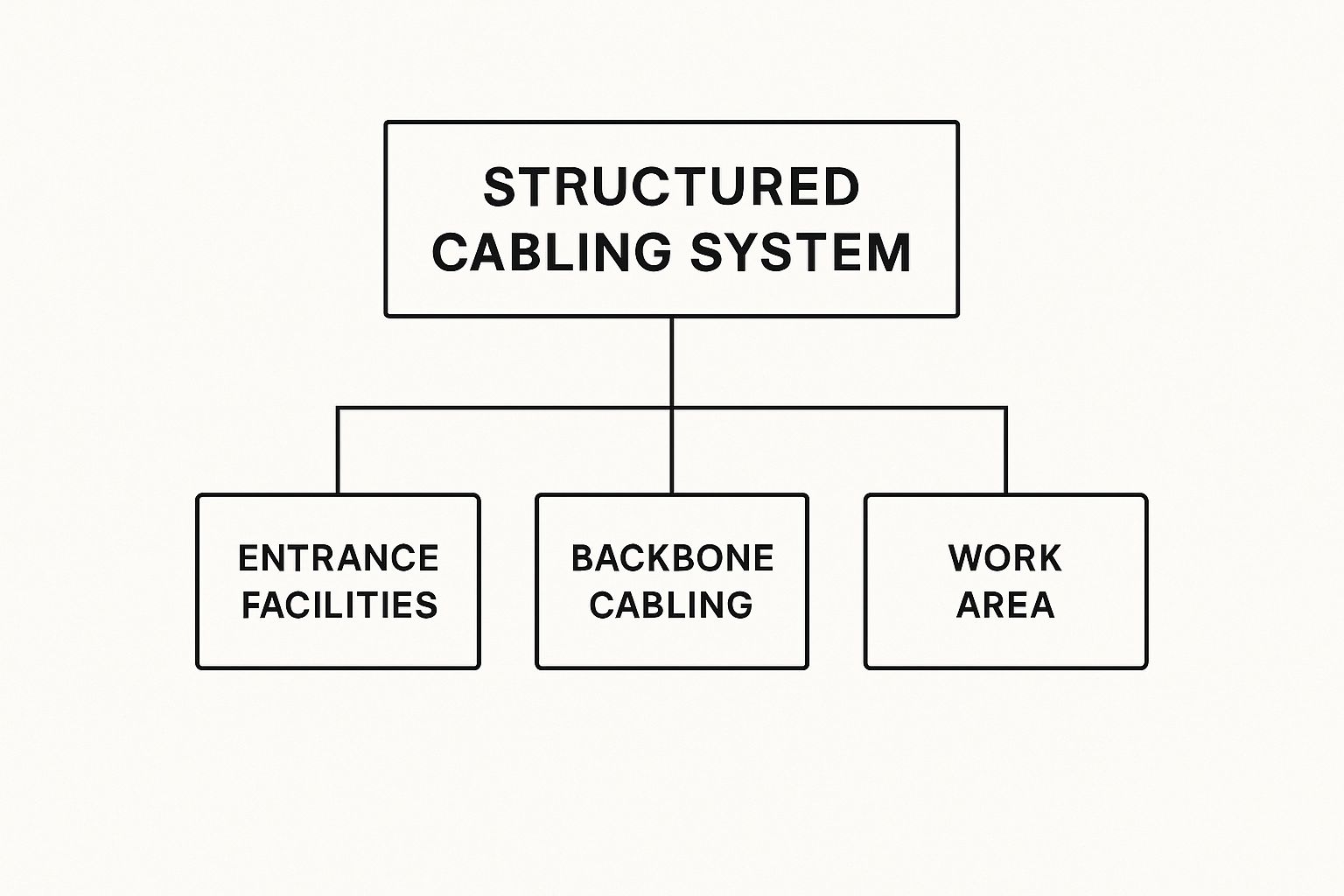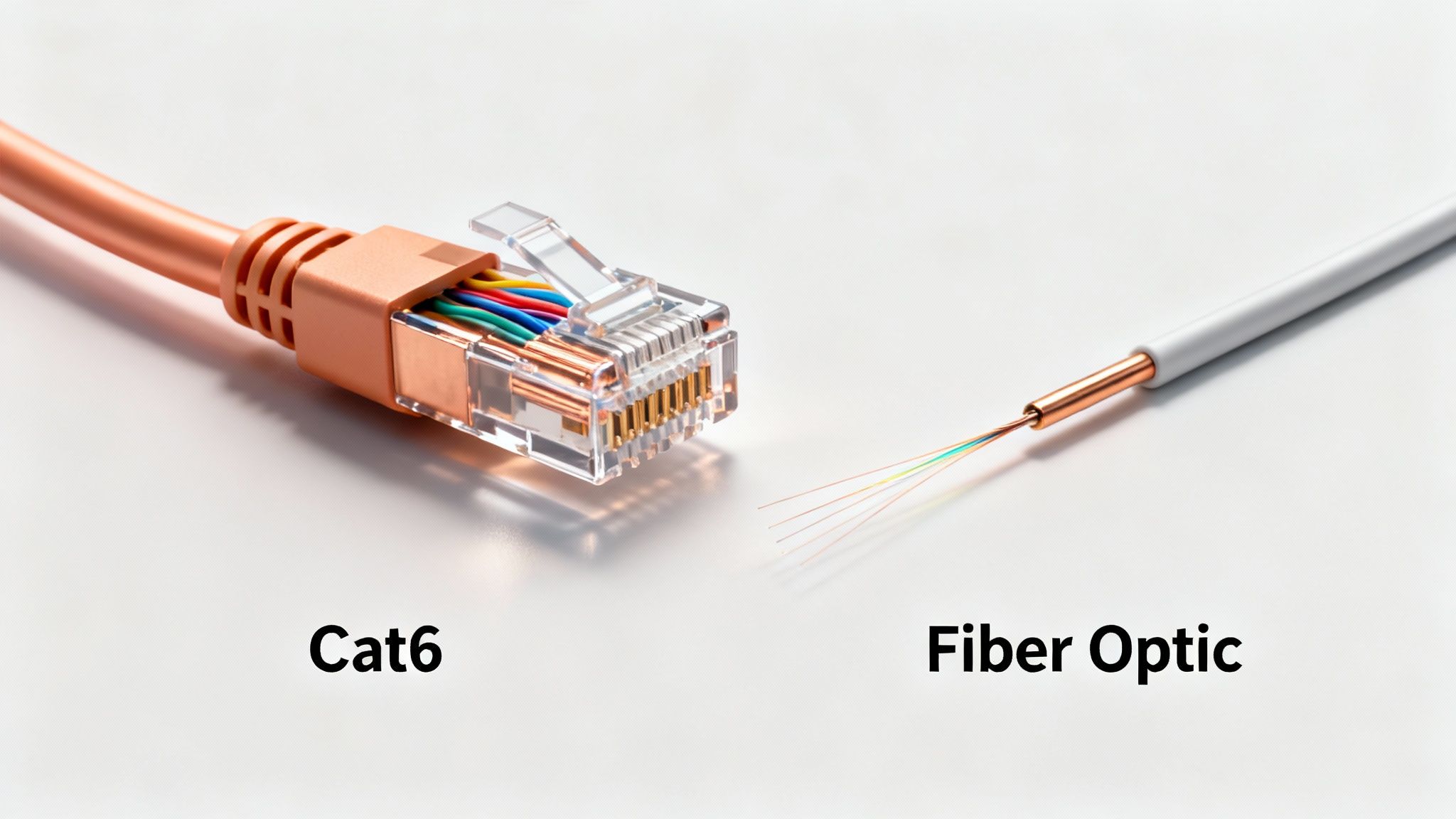Think of structured cabling as the central nervous system for your building. It’s a complete, organized system of low-voltage wiring and connectivity products that creates a reliable and flexible infrastructure for all your data, voice, and video needs.
This isn't about just running a few cables. It's a methodical approach that replaces the old, chaotic "spaghetti wiring" with a clean, logical network backbone built for the long haul.
Understanding Structured Cabling Without The Jargon

Let's break it down with an analogy. A traditional, messy wiring setup is like having tangled, individual wires running from the fuse box directly to every single light and outlet in your house. It’s a mess. Need to add a new outlet? You have to run another dedicated wire all the way back to the source. It’s confusing, expensive, and a nightmare to troubleshoot.
Structured cabling, on the other hand, is like having properly installed electrical wiring. You have a main panel, organized circuits, and outlets strategically placed in every room. When you want to plug in a new lamp, you just use the nearest outlet. You don't have to rewire the house.
This system provides a universal, pre-built infrastructure. So instead of running a separate wire every time you add a new computer, phone, or security camera, you simply plug it into a nearby port. It’s an efficient and forward-thinking way to handle the wiring that causes so many IT headaches.
The Foundation of Modern Networks
At its core, structured cabling is about building a rock-solid foundation for all your technology. It’s a standardized system designed to support a huge range of hardware and applications, not just for one building but across an entire campus if needed. This idea really took hold as computer networks became more complex and businesses realized they needed a better way to manage it all.
Structured cabling isn’t just an IT upgrade; it’s a long-term investment in business continuity and operational efficiency. It prepares your infrastructure for technologies that haven't even been invented yet.
Today, it's the bedrock for Local Area Networks (LANs), which account for over 80% of the structured cabling market. This highlights just how critical it is for offices, data centers, and pretty much any modern business. If you're interested in the market trends, you can find a great deal of information in this industry analysis on GrandviewResearch.com.
This planned approach is vastly superior because it anticipates future needs, makes management a breeze, and dramatically cuts down on potential network downtime. Every cable is neatly routed, properly terminated, and clearly labeled, making any moves, adds, or changes straightforward and fast.
Structured Cabling vs. Point-to-Point Wiring
To really see the difference, let's compare a modern structured system to the traditional ad-hoc approach. The table below lays out the key distinctions.
| Feature | Structured Cabling | Point-to-Point Wiring |
|---|---|---|
| Organization | Highly organized, labeled, and documented. | Chaotic and messy; often called "spaghetti wiring." |
| Scalability | Easy to expand and add new devices. | Difficult and costly to scale; requires new cable runs. |
| Troubleshooting | Simple and fast due to logical design. | Time-consuming and frustrating; hard to trace cables. |
| Flexibility | Supports multiple applications (data, voice, video). | Typically single-purpose and inflexible. |
| Reliability | High reliability with less downtime. | Prone to errors, signal interference, and failures. |
| Upfront Cost | Higher initial investment. | Lower initial cost but higher long-term expenses. |
As you can see, while point-to-point might seem cheaper at first, the long-term costs in maintenance, troubleshooting, and lost productivity make structured cabling the smarter investment.
The Six Core Subsystems Of A Cabling System
A structured cabling system isn't just a jumble of wires hidden behind walls. It's a highly organized, holistic network made up of six distinct subsystems. Each one has a specific job, and they all work together to create a reliable flow of data.
Think of it like the circulatory system in the human body. You have a heart (the Equipment Room), major arteries (the Backbone Cabling), and smaller vessels that deliver lifeblood all the way to your fingertips (the Work Area). Everything is connected logically, ensuring data gets exactly where it needs to go, efficiently and without interruption.
Following the Path of Your Data
The journey data takes through your building is predictable and structured. It starts at a single point of entry and branches out across your facility, moving from high-capacity pathways to individual user connections.
This diagram gives a great high-level view of how these components fit together, showing the data's journey from the outside world, through your building's core infrastructure, and finally to an employee's desk.

As you can see, it all starts at the Entrance Facilities and moves through the Backbone Cabling before being distributed out to each Work Area.
Let's unpack what each of these six subsystems actually does.
-
1. Entrance Facilities (EF): This is ground zero for your network connectivity. It’s the physical point where your service provider's network (like your internet or phone lines) connects to your building's internal wiring. It marks the official handoff—the "demarcation point"—from their responsibility to yours.
-
2. Equipment Room (ER): The nerve center of your entire network. This is a secure, climate-controlled space that houses the most critical hardware—servers, core switches, and routers. All major data pathways start here, making it the central hub for all network traffic.
-
3. Backbone Cabling: These are the superhighways of your network. Also known as vertical cabling, this is the heavy-duty wiring (often fiber optic) that connects the main Equipment Room to other hubs, like the telecommunications rooms on different floors. It’s built to handle a massive volume of data traffic.
-
4. Telecommunications Room (TR): Think of this as a mini-hub for a specific floor or section of your building. Often called a wiring closet, the TR is where the high-capacity backbone cabling connects to the smaller, localized horizontal cabling.
-
5. Horizontal Cabling: If the backbone is the highway, the horizontal cabling represents the local roads. These are the cables that run from the Telecommunications Room out to the individual wall outlets at employees' desks and workspaces. They're typically routed through ceilings or under floors.
-
6. Work Area (WA): This is the final stop on the data's journey. The Work Area includes everything from the wall plate and network outlet to the patch cords that plug directly into a user's computer, VoIP phone, printer, or other network-connected device. It's where your team actually connects to the network.
How Structured Cabling Drives Business Growth
It’s easy to think of network cables as just wires, but a professionally designed cabling system is a genuine strategic asset. It’s not just an IT expense; it’s a direct investment in your company’s efficiency, agility, and future. The methodical, organized nature of structured cabling completely changes how your business adapts to new demands.
Picture this very common scenario: Your company needs to bring on ten new employees, and they start Monday. With a structured system, it’s a weekend project at most. Each new desk already has a live network port ready to go—they just plug in and get to work. Zero disruption.
Now, imagine that same situation with a tangled mess of point-to-point wiring. You’re looking at days of downtime, paying technicians to run a new, ugly cable across the ceiling for every single workstation. The difference is night and day.
This same logic applies to fixing problems. When a network issue pops up, a properly labeled and documented system lets a technician find and fix the problem in minutes, not hours. That immediate boost to uptime keeps your team productive. For more on keeping things running smoothly, check out our guide on what is network redundancy.
Future-Proofing Your Operations
A professionally installed structured cabling system gives you the freedom to embrace new technology without tearing your office apart. Are you thinking about upgrading to VoIP phones, installing a new security camera system, or adding powerful wireless access points? The backbone is already there, ready to handle it.
This forward-thinking approach is exactly why the structured cabling market is expected to explode, growing from USD 14.23 billion in 2024 to USD 38.47 billion by 2034. Businesses everywhere are realizing they need a rock-solid network to support cloud applications, IoT devices, and 5G technology. You can see more details in this market forecast on PrecedenceResearch.com.
At the end of the day, making this investment gives you real, measurable advantages:
- Reduced Downtime: An organized, high-quality system is simply more reliable, which means fewer frustrating network outages.
- Faster Scalability: Adding a new employee, a new printer, or even an entire new department becomes a simple plug-and-play task.
- Lower Long-Term Costs: You stop paying for emergency "rip-and-replace" cable jobs and the recurring labor costs that come with a messy network.
Choosing The Right Cables For Your Network Needs

Picking the right cables is a foundational step in building a network that won't let you down. Think of it this way: you wouldn't run a sports car on cheap fuel and expect peak performance. The same logic applies to your network's physical layer. The two main options you'll encounter in structured cabling are copper and fiber optic cables, and each one has a specific job to do.
For the everyday needs of most offices—linking computers to the network, connecting printers, or powering devices like VoIP phone systems—copper twisted-pair cabling is the workhorse. It hits the sweet spot of being affordable, tough, and perfectly capable of handling the speeds required for standard business tasks.
On the other hand, fiber optic cable is the superhighway of network cabling. Instead of electrical signals, it uses light pulsed through thin glass strands to transmit data. This allows it to carry massive amounts of information over incredible distances at lightning-fast speeds. You'll typically find fiber used for critical backbone connections, like linking server rooms or connecting different buildings on a large property.
Copper Cable Categories Explained
Now, not all copper cables are created equal. They're organized into different categories (or "Cat" for short) that tell you how much performance you can expect. The higher the category number, the faster the speed and the more data it can handle.
Sticking to industry standards, like those from the TIA/EIA, is absolutely critical. These standards ensure your cabling performs reliably and your network investment is protected for years to come. It’s the difference between a certified, dependable system and a frustrating guessing game.
Here's a look at the most common categories you'll see in a modern business environment:
- Cat6: This is the current gold standard for most new office installations. It comfortably handles speeds up to 10 Gigabits per second (Gbps) over shorter runs and provides plenty of bandwidth for everyday work.
- Cat6a: The "a" stands for augmented. This cable is a step up, reliably delivering 10 Gbps speeds over the full 100-meter channel length, making it a smart choice for high-demand applications or for future-proofing your network.
To make things clearer, here’s a simple table comparing the common copper cable types.
Common Copper Cable Categories at a Glance
| Category | Max Speed | Max Bandwidth | Common Application |
|---|---|---|---|
| Cat5e | 1 Gbps | 100 MHz | Basic office networks, VoIP phones, older systems. |
| Cat6 | 10 Gbps (at ~55m) | 250 MHz | Standard for new business installations, video streaming. |
| Cat6a | 10 Gbps | 500 MHz | Data centers, future-proofing, high-demand devices. |
| Cat8 | 40 Gbps | 2000 MHz | High-speed data center connections (short-distance). |
This table shows just how far the technology has come. The evolution from one category to the next is driven by our ever-increasing need for speed and bandwidth. In fact, a recent report from CablingInstall.com highlighted that fiber optic cabling sales grew by 27% globally in 2024, fueled by the explosive growth of data centers. Even so, Cat6 cables continue to hold a massive share of the market, proving that a robust copper infrastructure remains essential for most businesses.
A Blueprint for a Flawless Installation
You can have the best cabling components in the world, but if they're not installed correctly, you're setting yourself up for a world of hurt. A messy installation is more than just an eyesore—it’s a direct path to frustrating network failures, slow speeds, and expensive troubleshooting down the line. A professional, methodical approach is what separates a reliable network from a ticking time bomb.
The real work starts long before a single cable is pulled. It all begins with a thorough consultation and design phase. We take the time to understand your current setup, where your business is headed, and the unique layout of your physical space. This strategic planning is the key to creating a network that’s not just fast today, but ready for whatever you throw at it tomorrow.
The Five Phases of Installation
A professional installation isn’t a chaotic race to the finish line. It's a carefully managed process, with each step building on the last to create a rock-solid and fully documented network foundation.
-
Design and Engineering: First, we map everything out. This is where we plan the most efficient cable routes, pinpoint the ideal locations for equipment, and determine where every outlet should go to meet both your immediate and future needs.
-
Cable Pulling and Routing: Next, we carefully run the cables through the planned pathways in ceilings, walls, and conduit. The key here is precision—protecting the cables from sharp bends, damage, or anything that could interfere with the signal.
-
Termination: This is a make-or-break step. Each cable end is meticulously attached to its connector, whether it's a wall jack or a patch panel. Even a slightly off connection here can cripple a cable's performance.
-
Labeling and Documentation: Every single component—every cable, port, and panel—is clearly labeled following industry standards. This creates an easy-to-follow map of your network, turning future troubleshooting from a nightmare into a simple task.
-
Testing and Certification: Finally, we don't just assume it works. We test every single cable run with specialized equipment to certify that it meets or exceeds performance standards. This final quality check is your guarantee that the network will perform exactly as designed from day one.
You can see how we apply this same methodical approach to all kinds of business technology with our professional network and equipment installations.
Your Network's Foundation for Success

When you get right down to it, structured cabling is so much more than just a neat bundle of wires. Think of it as the very foundation of your entire business's technology—the unseen, unsung hero that keeps everything running smoothly.
This is the system that enables clear communication, supports your most critical daily operations, and gives your company the flexibility it needs to adapt and expand. When you invest in a professionally designed and installed cabling system, you're not just buying wires; you're buying reliability, scalability, and long-term peace of mind.
You're building a network foundation that won't crumble under the pressure of future demands or technological shifts. This strategic asset ensures your operations remain agile and competitive for years to come.
Taking a deliberate, organized approach to your cabling is the secret to minimizing frustrating downtime, making network management far simpler, and ensuring your business is ready for whatever comes next.
Frequently Asked Questions About Structured Cabling
Deciding to overhaul your office network is a big move, and it's natural to have questions. To help you make an informed decision, we've put together straightforward answers to the questions we hear most often from business owners about structured cabling and what it means for their day-to-day operations.
How Long Does A Structured Cabling System Last?
Think of a professionally installed structured cabling system as a long-term investment in your building's infrastructure, much like its plumbing or electrical wiring. When done right with quality materials, the physical cables can easily last 10 to 20 years, sometimes even longer.
While you'll likely upgrade your active network gear (like routers and switches) every few years to keep pace with new technology, the cabling itself remains a solid, reliable backbone. This impressive lifespan makes it a fantastic return on investment, future-proofing the core of your network for years to come.
Can Structured Cabling Support Wi-Fi Devices?
Absolutely. In fact, a great Wi-Fi network depends on a great structured cabling system. It's the unsung hero working behind the scenes.
Every wireless access point (WAP) needs a physical cable running back to your network closet to get data and, in most cases, power via Power over Ethernet (PoE). A solid cabling foundation ensures your Wi-Fi isn't held back by a weak link, giving you the speed and stability to handle dozens of wireless devices without annoying lag or bottlenecks.
Is Structured Cabling More Expensive Initially?
Yes, the initial cost for a structured system is typically higher than just running a few cables from point A to point B as needed. But looking at the total cost of ownership tells a completely different story.
The upfront investment is quickly balanced out by major long-term savings. A structured system dramatically cuts down on the time, labor, and downtime needed for future moves, adds, and changes.
Troubleshooting a problem on a well-organized network takes minutes, not hours. Adding a new employee workstation is simple and clean. This foresight saves a ton of money and prevents the massive headaches that always come with a tangled, "spaghetti" network. It's a true investment in operational efficiency.
Keep your business running without IT headaches.
GT Computing provides fast, reliable support for both residential and business clients. Whether you need network setup, data recovery, or managed IT services, we help you stay secure and productive.
Contact us today for a free consultation.
Call 203-804-3053 or email Dave@gtcomputing.com


